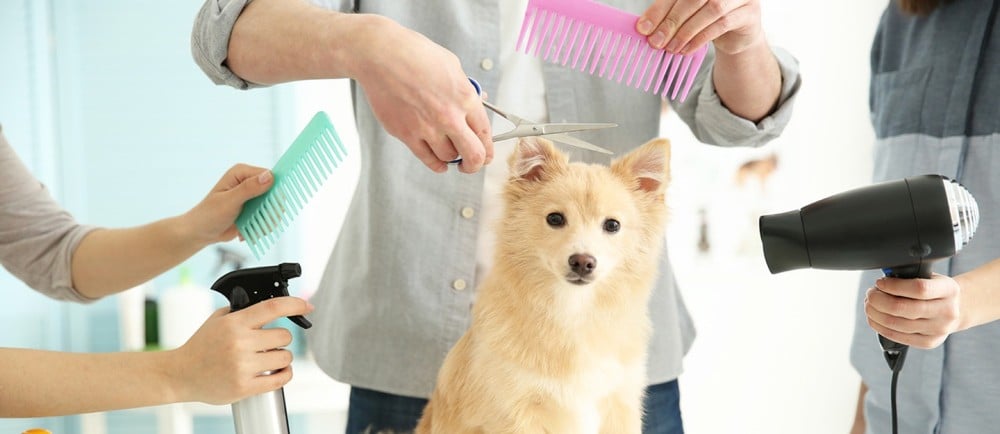
When should you shave your pet's hair and what effect does winter have on him if you shave?
It is not recommended to shave cats' hair in the winter except in special and necessary cases. Cat hair acts as a natural protective layer that helps maintain body heat and reduce heat loss. In winter, shaving is inconvenient because it leaves the cat without adequate protection from the cold.
If there is a need to shave the cat's hair, at least the hair must be left in a way that protects it from the cold. You can also talk to veterinarians for advice on caring for your cat's hair in the winter and whether there is a real need for shaving.
In general, it is best to provide the cat with a warm, blanketed area on cold days, and to make sure it has access to clean, appropriate food and water for the cold period.
Do cats and dogs need to take care of their hair all year round?
Whether your dog spends more time indoors during the winter with fewer outings, or if he is outside as much as he is in the summer, grooming is essential.
Despite the common belief that a dog's hair should be allowed to grow during the winter to maintain warmth, this can be more harmful than beneficial. If your dog's hair is left too long without regular grooming, it can create uncomfortable tangles and knots, leading to skin irritation and infection.
They should maintain regular grooming appointments and establish a daily routine of grooming their dogs between visits.
When a dog's undercoat becomes too tangled, it is unable to perform its main function of regulating its temperature, making it more likely to develop colds, along with the common skin problems and discomfort associated with knotted tangles and knots.
Regular release between visits can prevent this and should be practiced, regardless of season. As a general rule, you can recommend a slicker brush for dogs with long fur, as it helps maintain the top coat and remove unwanted hair. 
Ensuring adherence to the specified dates for cleaning, shaving and styling operations, in cooperation with Petaholic home services, whether for cats or dogs, small and large, over 12 kilograms, at home with our experts.
Does dog hair grow more quickly in winter?
The seasons affect how quickly a dog's fur grows. Longer daylight hours stimulate fur growth in the brighter summer months, so hair grows more quickly than in the cooler, darker months.
However, this does not mean that dog owners should reduce their dog's grooming appointments during the winter. Regular trimming can help maintain the fur and prevent it from being long and tangled.
Here are some other reasons you should encourage winter layoff appointments:
– Bathing, brushing, and moisturizing the fur help eliminate tangles and knots. Regular appointments can help keep stubborn tangles and knots under control.
- Dog paws consume less in winter when the ground is softer, and they spend more time indoors. By keeping up with regular grooming appointments, you can keep your dog's claws under control to avoid them becoming uncomfortable, breaking, or cracking.
– As hair continues to grow between the pads, it can collect snow, dirt and chemicals from deicers, causing pain for your dog while walking and exposing them to ingesting toxic chemicals. Advise your clients to wash their dog's paws after winter walks to avoid pain and discomfort, and then trim the paw hair during appointments to eliminate additional problems.
– Artificial heat can cause your dog’s skin to become dry and flaky, so it is important to keep grooming schedules so you can monitor the condition of his skin, which can be easily treated with a mild moisturizing shampoo and conditioner. Regular brushing between appointments removes dead skin and distributes natural oils throughout the fur. Winter styling prevents dry and cracked skin.
Do cats and dogs catch a cold when their hair is shaved in the winter?
A dog regulates its temperature very differently from a human, as heat is removed from its body through rapid breathing and the movements of its feet and nose.
However, this does not mean that shaving his fur is safe. Double-coated dogs, in particular, have a hard time dealing with fur shaving.
Shaving a double-coated dog to the undercoat prevents cold air from reaching the skin, as the undercoat acts as an insulator that works hard to retain heat.
This can also be harmful in the summer as shaving exposes you to the sun and increases the risk of overheating.
If your dog's coat is tangled and matted beyond repair, a thorough grooming may be the only option to help restore it to health and prevent the development of skin sensitivities and irritation. However, this should be used as another option for dogs with double coats.
Dogs with single coats, such as Maltese, can be shaved safely as their hair does not depend on temperature regulation as it does in dogs with double coats. If you shave a dog with one fur in the winter and notice that he is shivering, you can suggest to your client that he use dog clothing to keep warm during outings.
Why does the groomer shave the dog's belly?
Shaving your dog's legs and belly to provide a healthy hairstyle helps keep the hair on the belly and area around the back short to enhance grooming and keep them clean.
Tangles and knots can also be avoided when trimming belly hair. If the dog you are grooming has any tangles in this sensitive area, it may sometimes be easier to shave or trim the hair rather than brushing out the tangles.
5 winter care tips to help cats and dogs through the cold, dry months
1. Brush your cat or dog's thick hair often
Cats and dogs tend to shed more fur in the spring and fall. In the spring, they shed their winter fur, and in the fall, as temperatures begin to drop, they shed their fur to make room for new winter fur.
This means that your cat and dog's winter fur will usually be thicker to protect against the cold. For some cats, they may not groom themselves well during this period because there is a lot of fur.
It would be a good idea to brush your cat's fur more frequently during the shedding period and when they have a thicker winter coat. This will help avoid fur tangling and knots.
Start slowly using a pet brush or wide-toothed comb. Trim small areas of the cat's body at a time, helping him get used to this sensation.
2. Be careful with matted fur
If it's too late and your cat's fur is tangled, you'll need to trim it, but be careful! The cat is sensitive, so it may make sudden movements when pulling its fur.
Tangles can also be painful. Be sure to use pet clippers designed specifically for sensitive areas, and never clippers.
A cat's skin can be very delicate, and you don't want to risk cutting their skin while trying to get rid of tangles.
3. Help them get fashionable winter clothes
Helping them have healthier winter clothes can have a huge positive impact on the health and comfort of your pets during the winter season. Appropriate winter animal clothing is important for dogs and cats, especially in cold climates.
Winter clothes for cats and winter clothes for dogs can protect them from the cold and biting winds, especially if they need to go outdoors. It also helps maintain their body temperature and prevents them from being exposed to excessive cold, which is especially important for young animals that suffer from health problems such as rheumatism or arthritis.
You can check out the clothing section for dogs and cats with Petaholic , the agent for pet clothing brands
Before choosing clothing, make sure it is suitable for the size and type of your pet. Choose materials that are breathable and won't irritate the fur. The design should also be comfortable and easy to wear and take off.
If you are unsure about the appropriate type of clothing or how to avoid irritation or friction, you can consult your animal's veterinarian for additional advice and guidance.
4. Avoid static shock
In the winter, your cat may be more susceptible to static electric shock. Indoor heating can reduce the humidity in the air, leaving a drier, cooler climate that is more susceptible to static electricity. Sometimes, even touching your cat is enough to cause a small shock!
You can reduce static electricity in the air by adding a humidifier to the room. Before grooming, wipe your cat with a pet wipe. When bathing them, consider using a moisturizing shampoo.
According to PetMeds, you should never use fabric softening sheets on your cat. These leaves can contain chemicals that are toxic to cats!
5. Pay attention to painful joints
In the winter months when temperatures are colder, an elderly or arthritic cat's joints may flare up. This means they may feel pain sometimes, and will be more sensitive to touch. They may also not be as willing or able to clean themselves.
If you need to groom or groom a cat like this, be very gentle with them. If you need to “roll them like a burrito” in a towel to clip tangled fur or trim their nails, try heating the towel a little in the dryer first.
Remember, not all cats will accept being groomed, especially in the winter if they are more sensitive or have severe tangles. If your cat seems to be neglecting its fur, have it checked by your vet. Some veterinarians may shave problem areas or cut out bad tangles themselves.
Don't feel bad if you need to take your cat to a professional groomer . It just means that you care about your cat's health and help him be as comfortable as possible.

